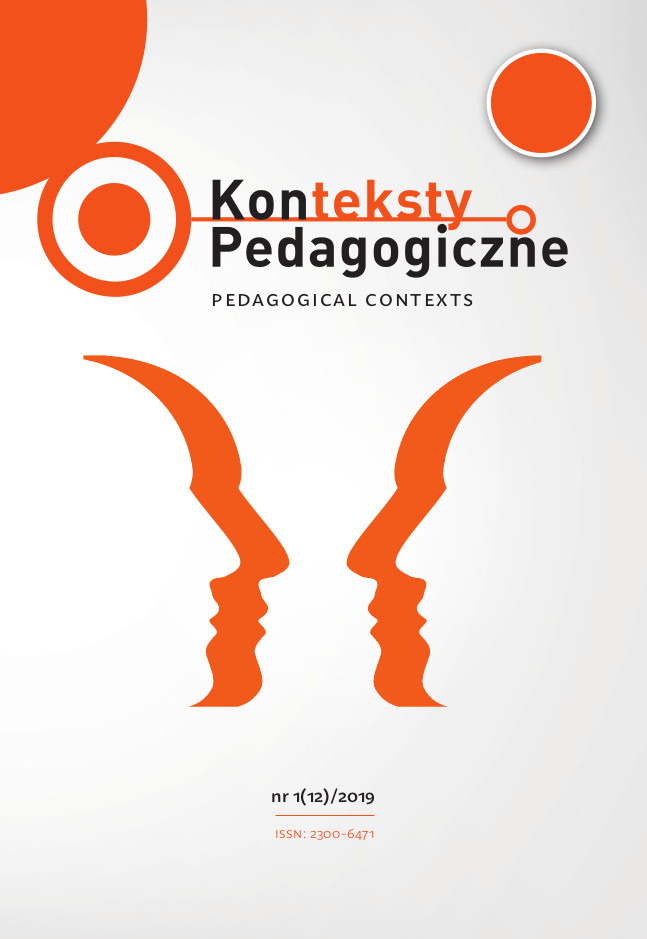Abstract
At their first stage of education, children face the intensified process of acquiring emotional and social competence, as well as developing interpersonal relations. It is of crucial value to make this process go smoothly and be well stimulated. In this era of modern threats, this process poses a challenge for teachers, forcing them to seek innovational and attractive educational methods which will enable them to have a gentle impact on the personal motivation of a young learner in his or her emotional and social abilities of interpersonal peer relations. This text is a description of research in the area of the use of art therapy in early learner education in the scope of their interpersonal relations. The author tries to demonstrate that art therapy can become a major key in resolving educational obstacles and can have a positive impact on interpersonal relations of children in their early education.
References
Chmielniecka-Płaskota, A., Łoza, B. and Szulc, W. (2014). Podstawy arteterapii [The Basics of Art Therapy] In: A. Chmielniecka-Płaskota and B. Łoza (eds.), Arteterapia [Art Therapy], PART 1 (pp. 13–20). Warszawa: Difin.
Florczykiewicz, J. (2015). Interdyscyplinarność arteterapii – sztuka jako przestrzeń działania arteterapeutycznego, Student niepełnosprawny [The Interdisciplinarity of Art Therapy - Art as a Therapeutic Space. A Disabled Student]. Szkice i Rozprawy [Sketches and Dissertations], 15(8), pp. 25–42.
Gilroy, A. (2009). Arteterapia – badania i praktyka [Art Therapy – Research and Practice]. Łódź: Wydawnictwo Akademii Humanistyczno-Ekonomicznej w Łodzi.
Glińska-Lachowicz, A. (2010). Arteterapia w warsztacie pedagoga resocjalizacyjnego – opinie studentów (doniesienie z badań własnych) [Art Therapy in the Work of a Rehabilitation Pedagogue - Student Opinions (A Report from Own Research)]. In: W. Szulc (ed.), Arteterapia jako dyscyplina akademicka w krajach europejskich [Art Therapy as an Academic Discipline in European Countries] (pp. 151–164). Wrocław: Wydawnictwo Uniwersytetu Wrocławskiego.
Gładyszewska-Cylulko, J. (2007). Wspomaganie rozwoju dzieci nieśmiałych poprzez wizualizację i inne techniki arteterapii [Supporting the Development of Shy Children through Visualization and Other Art Therapy Techniques]. Kraków: Impuls.
Gładyszewska-Cylulko, J. (2011). Arteterapia w pracy pedagoga [Art Therapy in the Work of a Teacher]. Kraków: Impuls.
Gulińska-Grzeluszka, D. (2011). Muzykoterapia dzieci agresywnych [Music Therapy for Aggressive Children]. Łódź: Wydawnictwo Akademii Techniczno-Humanistycznej w Łodzi.
Janicki, A. (1990).Arteterapia [Art. Therapy]. In: L. Hanek i M. Passella (eds.), Arteterapia [Art Therapy] (pp. 14–22). Wrocław: Akademia Muzyczna im. Karola Lipińskiego we Wrocławiu.
Kuciapiński, M.J. (2013). Wpływ arteterapii na rozwój osobowy dzieci w wieku przedszkolnym [The Impact of Art Therapy on the Personal Development of Preschool Children]. Pedagogika Rodziny [Family Pedagogy], 3(3), pp. 17–35.
Malinowska, J., Jabłońska, M. (2016). Przez edukację artystyczną i środowiskową do zrównoważonego rozwoju [Through Artistic and Environmental Education to Sustainable Development]. Konteksty Pedagogiczne [Pedagogical Contexts]1(6), pp. 67–85.
Pikała, A. and Sasin, M. (2016). Arteterapia, scenariusze zajęć [Art Therapy, Class Scenarios]. Łódź: Wydawnictwo Uniwersytetu Łódzkiego.
Szabelska, G. (2012).Diagnostyczna funkcja terapii sztuką: zastosowanie analizy rysunku rodziny w procesie wczesnego rozpoznawania dziecka krzywdzonego w środowisku rodzinnym [The Diagnostic Function of Art Therapy: the Use of Family Drawing Analysis in the Process of Early Recognition of Child Abuse in Family Environment]. In: B. Kaczorowska and W. Karolak (eds.), Arteterapia. Od rozważań nad teorią do zastosowań praktycznych [Art Therapy. From Theoretical Considerations to Practical Applications] (pp. 297–314). Łódź: Wydawnictwo Akademii Humanistyczno-Ekonomicznej w Łodzi.
In accordance with the recommendation of the Ministry of Science and Higher Education, which aims to counteract the practice of “ghostwriting” and “guest authorship,” all authors submitting their text for publication should attach an author’s statement which declares the contribution of each of the authors to the article. The printed and signed statement should be delivered by mail or other means to editor-in-chief Joanna Skibska or sent in the form of a scan to the following e-mail address: redakcja@kontekstypedagogczne.pl. The authors will not receive remuneration for publishing their papers. The editors reserve the right to make minor editorial changes to the articles which will not affect the substance of the article. We encourage all authors to prepare their articles in accordance with the guidelines for manuscript preparation. Download pdf file.
Authors transfer all copyrights and grant the journal the right of first publication with the work simultaneously licensed under a Creative Commons Attribution License that allows others to share the work with acknowledgement of the work's authorship and initial publication in this journal. All authors agree to the publishing of their email addresses, affiliations and short bio statements with their articles during the submission process.

